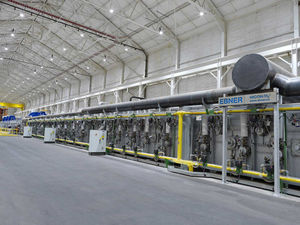

- Products
- Catalogs
- News & Trends
- Exhibitions
Bell furnace HITTheat treatmentannealinggas








Add to favorites
Compare this product
Characteristics
- Configuration
- bell
- Function
- heat treatment, annealing
- Heat source
- gas
- Atmosphere
- nitrogen, hydrogen, 100% hydrogen atmosphere
- Other characteristics
- high-temperature, for steel
- Maximum temperature
Max.: 1,150 °C
(2,102 °F)Min.: 0 °C
(32 °F)
Description
High-temperature anneals (HTA) of grain-oriented (GO) electrical strip are used to form grains with magnetically advantageous Goss textures through secondary recrystallization. The high processing temperatures (above 1150 °C) and straight hydrogen atmospheres also remove sulfur and nitrogen. A coating of MgO, added in a previous step, inhibits the formation of stickers in the wraps.
The safety concept for processing in hydrogen has been adopted from HICON/H2 annealers. The charge is heated by thermal energy radiating from the heating bell and inner cover.
The following advantages over other facility types are provided by the EBNER design:
Encapsulated, gas-tight workload space ensures significantly lower atmosphere consumption (savings of up to 50 %), compared to alternative designs
Rapid heating up and cooling, with possible hydrogen concentrations up to 100 %
→ significant increase in productivity compared to 100 % nitrogen atmospheres
Further reductions in hydrogen consumption are possible if a hydrogen recycling system is installed
The homogenous temperature distribution within a stack, provided by patented coil supports
and symmetrical heating, ensures:
homogenous magnetic characteristics
shortened annealing cycles
and extends the service life of the inner covers
Catalogs
No catalogs are available for this product.
See all of EBNER‘s catalogsRelated Searches
- Furnace
- Chamber furnace
- Electric furnace
- Heat treatment furnace
- Drying furnace
- Laboratory furnace
- Combustion furnace
- Gas furnace
- Tunnel furnace
- Industrial furnace
- Controlled atmosphere furnace
- High-temperature furnace
- Automatic furnace
- Vacuum furnace
- Continuous furnace
- Annealing furnace
- Forced convection furnace
- Thermal furnace
- Horizontal furnace
- Quenching furnace
*Prices are pre-tax. They exclude delivery charges and customs duties and do not include additional charges for installation or activation options. Prices are indicative only and may vary by country, with changes to the cost of raw materials and exchange rates.








